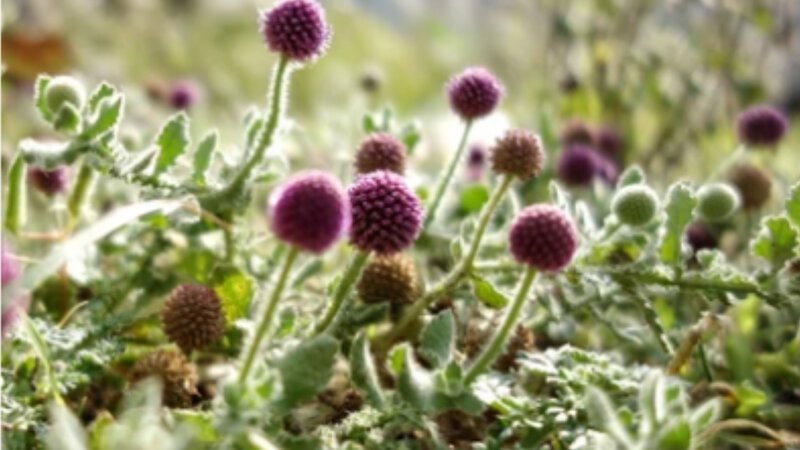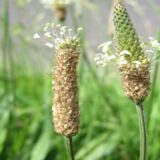Gorakhmundi Plant (Sphaeranthus Indicus) Health Benefits & Uses
Sphaeranthus indicus Linn is among those whose whole plant is used to treat various diseases. Sphaeranthus indicus (Asteraceae) is commonly known as Gorakhmundi.
It is used for various diseases in the Indian system of traditional medicine known as Ayurveda. Sphaeranthus indicus is a plant species that belongs to the Sphaeranthus family of Asteraceae.
It is an aromatic herb with spreading the spread of glandular hairy stems and branches with purple or pink flowers. It has Stems with toothed wings, and alternate, toothed leaves.
The flowers are terminal, globose with purple inflorescence heads. It is also known by various names such as the “East Indian globe thistle” in English and Mundi, Gorakhmundi in Hindi Bengali, Marathi, and Gujarati. Mundi is the Sanskrit word literally means that which cuts off or wards off.
In the ancient scriptures of Ayurveda, it is mentioned to be one of the best herbs used as Rasayana Madhya – intellect promotes grass.
Other Indian Names
• Sanskrit: Mundi, Śrāvani Kadamba, Pus.pikā, Alambusta
• Assamese: Kamadarus
• Bengalese: Surmuriya, Chhagal Nadi, Mudmudiya
• Gujarati: Gorakhmundi
• Hindi: Mundi
• Kannada: Mirnagnee, Atookamanni, Mirangnee
• Marathi: Mundi, Baras Bondi
• Oriya: Buikadam
• Punjabi: Gorakhmundi
• Tamil: Kotook, Karandai, Kottakarthai
• Telelugu: Bodasaramu, Bodataramu
• Urdu: Mundi.
Ayurvedic Properties
- Rasa:– Tikta, Katu
- Guna:– Laghu, Ruksha
- Veerya:– Ushna
- Vipaka:– Katu
Sphaeranthus Indicus is pungent, bitter, and sweet in taste, pungent in the post-digestive effect, and has hot potency. It Alleviates Kapha and Vata doshas, it is light and dry in nature.
It can be used as a nerve tonic, diuretic, vermicide, and blood purifier. It is also useful in various diseases such as skin diseases, epilepsy, obesity, filariasis, anemia, diseases of the anus and vagina channel, etc.
Ethnomedicinal Uses
- Oil Of Root Herb: Treatment of scrofula, aphrodisiac.
- Seeds Paste Treatment of pruritus, edema, arthritis, filariasis, gout, Adenopathy.
- Roots: Stomachic and anthelmintic.
- Flower Heads: Blood purifier in skin diseases.
- Powdered Leaves: Treatment of chronic skin diseases, urethral discharges, and jaundice.
- Fresh Leaves: Anxiolytic, macrofilaricidal, antimicrobial, and insecticidal activities.
- Plant Juice: Liver and gastric disorders.
Sphaeranthus Indicus Medicinal Uses
Speaking of health benefits, the benefits of Gorakhmundi are very high, it is necessary to have information about them. Therefore, the other benefits of Gorakhmundi are as follows:
- Useful for inflammation: Make a paste of the Gorakhmundi plant and place it in the affected area of swelling. This helps in reducing your swelling.
- Take away headache: To treat headaches including migraine cases, black pepper powder should be consumed with 10 to 15 ml fresh juice of the Gorakhmundi plant.
- Beneficial for indigestion: By preparing the decoction of this Ayurvedic plant, it removes indigestion, intestinal worms, and liver problems. For this, 50-60 ml of this decoction should be consumed.
- Treat asthma: To treat chronic cough and asthma, 40-50 ml of Gorakhmundi’s cold infusion should be consumed.
- In the treatment of epilepsy: Plant juice acts as a nervine tonic that can treat general weakness and epilepsy.
- Useful for ringworm: To get rid of herpes, make a paste of the Gorakhmundi plant and apply it on the ring regularly.
Medicinal Properties And Uses of Gorakhmundi
Sphaeranthus indicus, commonly known as Gorakhmundi or Mundi, is a plant known for its various medicinal properties. Here are some of the medicinal properties associated with Sphaeranthus indicus:
1. Anti-inflammatory: Sphaeranthus indicus possesses anti-inflammatory properties, which can help reduce inflammation in the body and alleviate related symptoms.
2. Antioxidant: The plant is rich in antioxidants that help combat oxidative stress and neutralize harmful free radicals in the body, which can contribute to overall health and well-being.
3. Analgesic: Sphaeranthus indicus has analgesic properties, making it effective in reducing pain and providing relief from discomfort.
4. Antimicrobial: The plant exhibits antimicrobial activity against certain bacteria, fungi, and viruses, which can contribute to its potential in combating infections.
5. Hepatoprotective: Sphaeranthus indicus is known for its hepatoprotective properties, which means it helps protect the liver from damage and promotes its healthy functioning.
6. Anti-diabetic: Studies have suggested that Sphaeranthus indicus may have anti-diabetic properties, helping regulate blood sugar levels and potentially benefiting individuals with diabetes.
7. Anticancer: Some research has indicated that Sphaeranthus indicus may possess anticancer properties, exhibiting potential in inhibiting the growth of cancer cells and preventing their proliferation.
8. Anti-obesity: The plant has been studied for its anti-obesity effects, showing promise in weight management and reducing body fat accumulation.
9. Anti-allergic: Sphaeranthus indicus has been traditionally used for its anti-allergic properties, providing relief from allergic reactions and symptoms.
10. Neuroprotective: Research suggests that Sphaeranthus indicus exhibits neuroprotective effects, potentially benefiting brain health and protecting against neurodegenerative diseases.
11. Antispasmodic: Sphaeranthus indicus has antispasmodic properties, which can help relax muscles and relieve muscle spasms or cramps.
12. Anti-anxiety: The plant is believed to have anti-anxiety properties, helping to reduce anxiety and promote a sense of calmness and relaxation.
13. Diuretic: Sphaeranthus indicus acts as a diuretic, promoting the production of urine and aiding in the elimination of excess fluids and toxins from the body.
14. Antipyretic: It is thought to possess antipyretic properties, which can help reduce fever and alleviate associated symptoms.
15. Antihyperlipidemic: Research suggests that Sphaeranthus indicus may have antihyperlipidemic effects, meaning it can help regulate lipid levels in the blood, such as cholesterol and triglycerides.
16. Wound healing: The plant has been traditionally used for its wound-healing properties. It may aid in the regeneration of skin cells and promote faster healing of wounds.
17. Anti-arthritic: Sphaeranthus indicus is believed to possess anti-arthritic properties, which can help reduce joint inflammation and alleviate symptoms associated with arthritis.
18. Antispasmodic: The plant is known for its antispasmodic effects, which can help relieve spasms and cramps in the digestive system, providing relief from digestive disorders.
19. Immunomodulatory: Sphaeranthus indicus is thought to have immunomodulatory properties, meaning it can help regulate and strengthen the immune system’s response.
20. Cardioprotective: Research suggests that Sphaeranthus indicus may have cardioprotective effects, helping to maintain cardiovascular health and reduce the risk of heart-related conditions.
Note: It’s important to note that while Sphaeranthus indicus shows potential in these medicinal properties, further scientific research is necessary to fully understand its effectiveness and mechanisms of action.
It is recommended to consult with a healthcare professional or Ayurvedic practitioner for personalized advice and appropriate usage of Sphaeranthus indicus for specific health conditions.

























